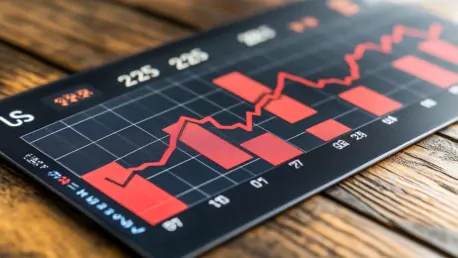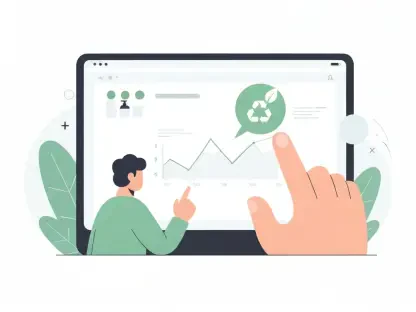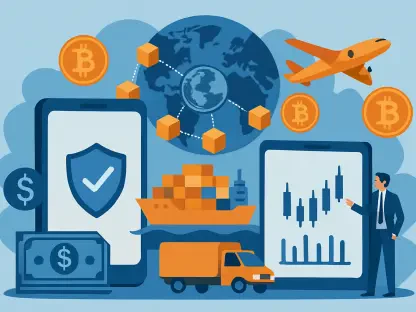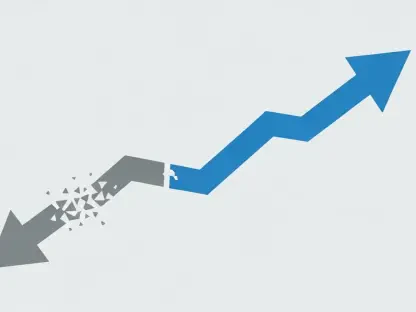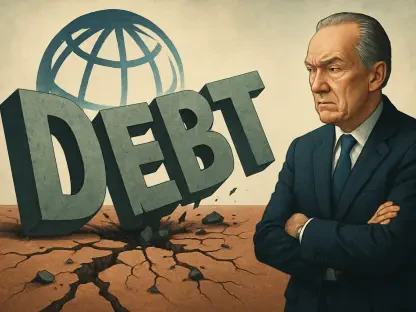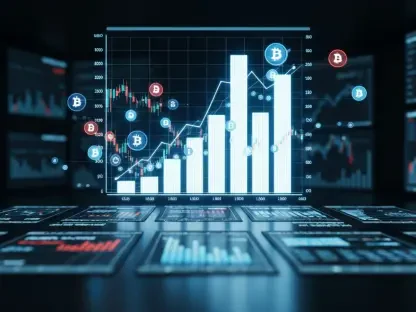In 2025, concerns are mounting about an impending economic downturn in the United States. Predicted by JPMorgan Chase, the largest investment bank globally, this potential recession may stem from recent tariff policies imposed under President Donald Trump. As these projections spark discussions, the possible consequences for the U.S. economy require analysis.
Economic Contraction
Predicted GDP Decline
JPMorgan Chase forecasts a notable contraction in GDP, with estimated decreases of 1% in the third quarter and 0.5% in the fourth quarter of 2025. This reflects a significant shift from the previously expected annual growth figure of 1.3%, predicting an overall decline of 0.3%. The adjustment underscores the potential severity of economic changes rooted in present trade policies. A shrinking GDP may have cascading effects throughout various sectors, highlighting a broader economic deceleration.
Economic growth expectations were recently recalibrated in light of new tariffs. The revised forecast contrasts sharply with prior optimism, signaling urgent trouble spots for economic stakeholders. Policymakers, businesses, and consumers alike should be prepared for the challenges posed by these conditions. The downward revision suggests reduced investments, lower consumer spending, and potential declines in industrial production, which collectively suggest a more guarded economic outlook moving forward.
Consequential Impact
Such a contraction signals a deviation from earlier optimistic projections and suggests an upcoming slowdown in economic activities. The newly implemented tariffs play a crucial role in this downturn. As tariffs drive up costs on imported goods, businesses face increased expenses, which can stifle growth. This situation perpetuates a cycle wherein higher prices reduce consumer spending power, leading to lower demand and further inhibiting economic momentum.
The predicted GDP dip is set to affect various facets of the economy, from corporate earnings to job creation. Business investment may wane due to heightened uncertainty and cost pressures, while consumer confidence could erode amid rising prices. These effects demonstrate how interwoven aspects of the economy are, evidencing that a single policy shift can reverberate throughout, causing widespread downward spirals. For policymakers, the priority will be to mitigate these challenges to steward the economy through these turbulent times effectively.
Rising Unemployment
Unemployment Projections
JPMorgan’s chief economist, Michael Feroli, projects that the unemployment rate could rise to 5.3%, up from 4.2% recorded in March. This spike is linked directly to the anticipated slowdown in economic growth. Unemployment levels reflect the health of the economy and high rates traditionally suggest nearly one in twenty individuals actively looking for work cannot find employment. This outlook has substantial implications, highlighting the urgency for strategies that can potentially stimulate job creation or sustain existing employment levels.
The significant increase in unemployment stems from shrinkages across multiple economic sectors. Job losses are notably anticipated in industries closely tied to international trade. This rising trend in unemployment translates into more households experiencing financial uncertainty, which further dampens consumer spending, reducing overall economic demand. Thus, understanding this projection helps stakeholders prepare and create comprehensive responses to mitigate its potential socioeconomic fallout.
Sector-Specific Effects
Particularly vulnerable sectors, like automotive, electronics, and textiles, face the brunt of job losses due to these tariffs, affecting a large number of workers in industries heavily dependent on imports. These sectors, integral to the supply chain, demonstrate how new tariffs can dismantle labor stability. Companies in these industries depend heavily on imported components for production. Increasing tariffs interrupts this, directly impacting employment rates.
Automotive, electronics, and textile industries exemplify the domino effect tariffs can create. A tariff hike increases production costs leading to higher final product prices, reducing competitiveness, and consequently; sales drop. This leads to reduced revenues, forcing companies to adjust by cutting jobs to sustain profitability. The cascading impact from these sector-specific changes paints a clear picture of widespread economic vulnerability. Effective counteraction measures will have to focus not just on job retention but also on transitioning workforces into evolving economic areas.
High Inflation
Inflation Trends
Inflation is expected to surge to 4.4% by the end of the year, a steep rise from 2.8% in February. This increase is driven by high tariffs on imports from several major trading partners. As tariffs elevate import prices, producers pass these costs on to consumers, who face rising prices for everyday goods. The predicted inflation rate indicates accelerating price increases for both consumers and businesses, which complicates financial planning and savings.
Such inflationary pressure is a significant economic disruptor. Rising costs reduce purchasing power, straining household budgets and limiting discretionary spending. This amplified inflation rate exposes households to considerable price hikes, impacting their quality of life and necessitating substantial adjustments to their financial behaviors. From a broader perspective, sustained high inflation can anchor expectations, leading to a continuous cycle of wage demands and price setting that further entrenches the issue.
Consumer Impact
Rising prices can substantially burden consumers, reducing their spending power and contributing further to economic challenges. This inflationary trend complicates the economic landscape. Higher costs across essential goods and services force consumers to cut back on non-essential expenditures, which impinges on overall economic activity. Consequently, businesses face lower demand, which leads to potential revenue declines and slows economies down further.
The consumer impact of high inflation extends beyond immediate price adjustments. Prolonged inflation erodes real incomes, meaning even though nominal wages might rise, they fail to keep pace with inflation, effectively reducing purchasing power and quality of life. This scenario places additional pressure on wage negotiations, labor disputes, and can lead to a downward spiral if not addressed with effective policy measures. For policymakers and businesses, it becomes crucial to find a balance that maintains economic stability while protecting consumer interests.
Stagflation Environment
Characteristics and Challenges
The U.S. might experience stagflation, marked by low growth and high inflation. This scenario creates a difficult environment for economic policymakers as they navigate these dual adverse conditions. Stagflation’s unique combination of stagnation and inflation represents a significant deviation from standard economic problems, combining minimal growth with soaring prices. This dual challenge makes traditional policy responses less effective.
The characteristics of stagflation render it particularly challenging to manage due to conflicting needs for stimulus and restraint. Efforts to boost growth through monetary easing may exacerbate inflation, while measures to curb inflation through tightening can further dampen growth. The complexity of managing both simultaneously demands sophisticated and sometimes unconventional policy solutions. Policymakers are tasked with walking a fine line, balancing competing economic priorities to navigate this intricate landscape effectively.
Policymaker Dilemmas
The Federal Reserve, under Jerome Powell’s leadership, faces the tricky task of balancing measures to spur growth while managing inflation, influencing their policy decisions significantly. Policymakers are caught between the need to incentivize economic activity and the imperative to contain rising prices. These challenges are compounded by the unpredictable interactions between new tariffs and existing economic dynamics.
This dilemma forces the Federal Reserve to consider nuanced approaches that involve a careful calibration of interest rates and potentially unconventional monetary tools. The necessity to support growth while curbing inflation creates policy contradictions that require careful navigation. Jerome Powell’s Federal Reserve may have to employ a strategic mix of interest rate adjustments and other economic levers to steer the economy through these trying times. The complexity of these policy choices underscores the sophisticated balancing act involved in managing stagflation effectively.
Federal Reserve’s Possible Response
Predicted Rate Cuts
In anticipation of a recession, it is predicted that the Federal Reserve will commence interest rate cuts starting in June 2025. These measures aim to stimulate the economy, targeting a rate range between 2.75% and 3% by early next year. This policy shift signifies an adaptive response to the potential slowdown, aiming to inject liquidity into the markets and encourage borrowing and investment.
Lowering interest rates is an effective tool to counteract economic recessionary pressure. By making borrowing cheaper, businesses and consumers are incentivized to spend and invest more, potentially spurring economic growth. However, this approach needs careful application to avoid further fueling inflation. The rate cuts, therefore, exemplify a considered strategy to balance the intricate dynamics of a slowing economy amidst rising inflation, presenting a nuanced handling approach by the Federal Reserve.
Strategic Considerations
These possible rate adjustments reflect a strategic approach to counteract economic stagnation while providing the necessary stimulus to support recovery efforts. The Federal Reserve’s potential moves are part of a broader strategy to stabilize the economy and guide it through a turbulent period. However, these measures are not without risk, requiring precise calibration to avoid unintended inflationary consequences.
Strategic considerations involve analyzing the timing and scale of interest rate cuts thoroughly. The Federal Reserve must weigh the current economic conditions against projected outcomes, adjusting their approach as necessary to mitigate adverse impacts. These strategic decisions underline the complexity of managing an economy on the brink of recession, highlighting how the Federal Reserve’s actions play a pivotal role in shaping broader economic trajectories. The policy responses must be adaptable and responsive to evolving economic indicators to maintain stability.
Immediate Market Reactions
Stock Market Response
The prediction by JPMorgan has already caused significant declines in major stock indices such as the S&P 500, Dow Jones, and Nasdaq. The market’s sensitivity to these forecasts underscores investor anxiety. Sharp reactions in stock markets signal concerns about the economic future and reflect broader apprehensions regarding trade policies and their potential repercussions.
Immediate downturns in stock prices point to a broader uncertainty in the investment landscape. Investors react promptly to such predictions, reevaluating their portfolios, and often moving toward more stable assets. This volatility can lead to significant shifts in market dynamics, impacting both short-term and long-term investment strategies. The market behaviors serve as a barometer for larger economic anxieties and readiness to adapt to the new economic realities as impacted by trade policies.
Broader Market Impacts
These reactions indicate a broader concern among market participants about the economic implications of current trade policies and their potential to drive a recession. Market volatility amplifies the uncertainty that businesses and investors face, potentially discouraging investment and stalling economic activities. Such reactions underscore the symbiotic relationship between policymaker decisions, economic forecasts, and market responses.
The broader impacts extend beyond immediate stock market fluctuations. The reactions can trigger wider effects on corporate strategies and consumer confidence. Business planning becomes more conservative in an uncertain economic climate, leading to reduced capital expenditures, hiring freezes, or even layoffs. In turn, this impacts consumer sentiment, compounding the effect on economic growth. The interconnectedness of market responses and real economic activities highlights the nuanced impact of economic predictions and the critical need for careful, informed policymaking.
Overarching Trends
Consensus Among Financial Institutions
Other financial institutions, including Barclays, Citi, and UBS, share a similarly pessimistic outlook, projecting a restrained view of the U.S. economy extending beyond 2025. This consensus amplifies the weight of JPMorgan’s forecasts, suggesting a broadly recognized risk. These consistent predictions underline a comprehensive outlook shaped by detailed analysis and present economic realities.
The shared pessimism from multiple reputable financial entities reinforces the gravity of the outlook. A coordinated concern among leading institutions reflects deep analytical convergence, pointing towards significant challenges ahead. This shared outlook calls for a concerted response from policymakers, businesses, and stakeholders to navigate the projected economic headwinds effectively, emphasizing the seriousness of the anticipated economic scenario.
Trade and Job Implications
Expected reductions in imports, coupled with rising consumer costs and significant job losses, highlight the broader economic adjustments and risk scenarios shaping these forecasts. The high tariffs modify trade dynamics significantly, impacting sectors highly dependent on imports. The predicted downturn reflects these overarching trends, framing a broad economic narrative influenced by complex interdependencies.
Trade disruptions and job implications underscore the broad economic adjustments that the U.S. faces. A comprehensive understanding of these dynamics highlights the multifaceted challenges inherent in managing both local and international economic relationships. Policymakers need to employ adaptive strategies to mitigate these impacts, preserve employment, and stabilize trade relationships. The broader implications necessitate a holistic approach, emphasizing adaptability and proactive measures to meet the complex economic landscape head-on.
Synthesizing Perspectives
Unified Understanding
Examining predictions from varied institutions offers a comprehensive view of potential outcomes. The economic strain from tariffs, combined with Federal Reserve’s countermeasures, shapes a critical period for the U.S. economy. The nuanced perspectives provide depth to the overall understanding, illustrating the intertwined dynamics at play. This multifaceted analysis aids in forming a unified understanding of the key issues and proposed solutions.
The synthesis of diverse insights highlights how predicted economic uncertainties intersect. A unified understanding derived from different analyses presents a coherent narrative that equips policymakers, businesses, and consumers with a better grasp of the impending challenges. This comprehensive perspective allows for more robust and informed decisions to be made, fostering a more strategic and resilient approach to navigating the economic landscape.
Diverse Analyses
Recent trade policies have prompted diverse analyses, reflecting both short-term impacts and long-term strategic concerns. Having a balanced perspective aids in understanding the gravity and nuance of the issue. By examining these different viewpoints, a more rounded and detailed picture emerges, incorporating various elements and their interrelations within the economic context. Diverse analyses enrich the discourse, promoting a well-informed and balanced approach to the projected economic conditions.
These varied insights highlight the complexity of the economic terrain and the multitude of factors at play. They underscore the necessity of considering multiple aspects, from immediate economic reactions to long-term strategic implications, in crafting responses. The integration of diverse analyses into a cohesive framework provides an enriched understanding that can guide more effective policies and preparations, ensuring resilience through anticipated economic challenges.
Concluding Considerations on Economic Strategies
In 2025, growing concerns about an impending economic downturn in the United States have become a focal point for economists and policymakers. JPMorgan Chase, renowned as the largest investment bank worldwide, has forecasted a possible recession. This potential economic slump is believed to be linked to the tariff policies enacted during President Donald Trump’s administration. These tariffs, which were intended to protect domestic industries, have had significant impacts on international trade relations and supply chains. As discussions around these projections intensify, it is crucial to analyze the potential outcomes for the U.S. economy. This analysis requires a detailed examination of employment rates, consumer spending, and global trade dynamics. Additionally, scrutinizing how these tariffs have influenced inflation rates and business investments provides insight into the broader economic challenges the nation might face. Understanding the potential consequences is essential for developing strategies to navigate and mitigate the effects of a possible recession.
